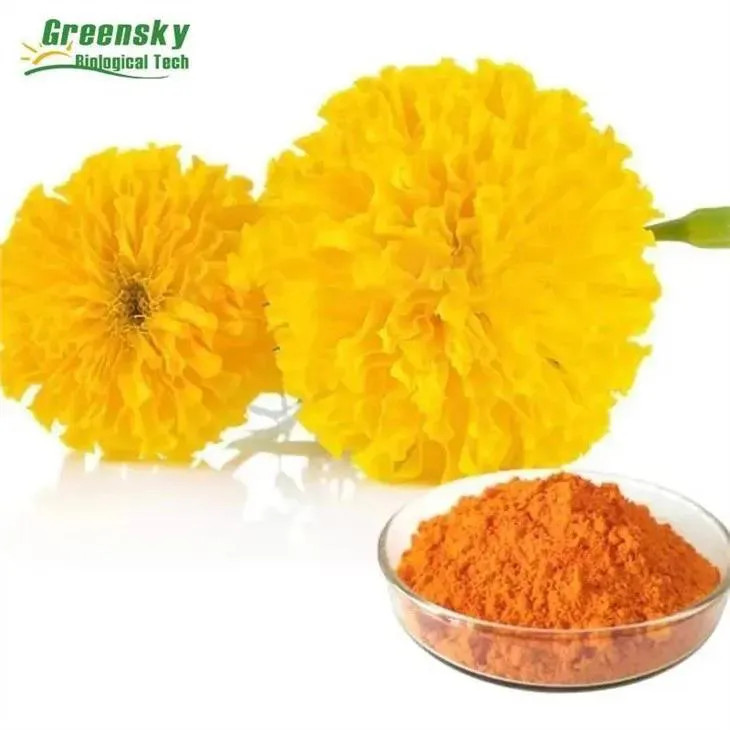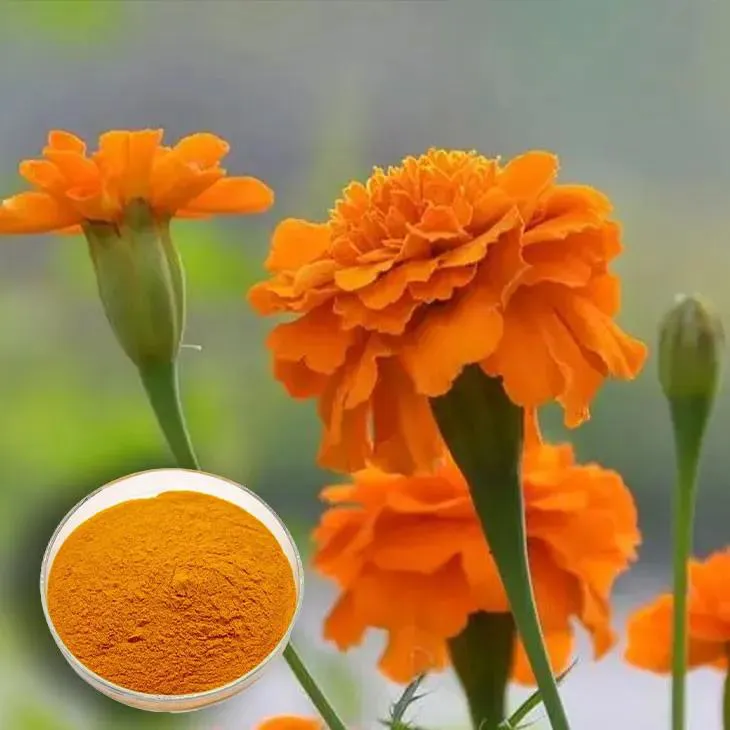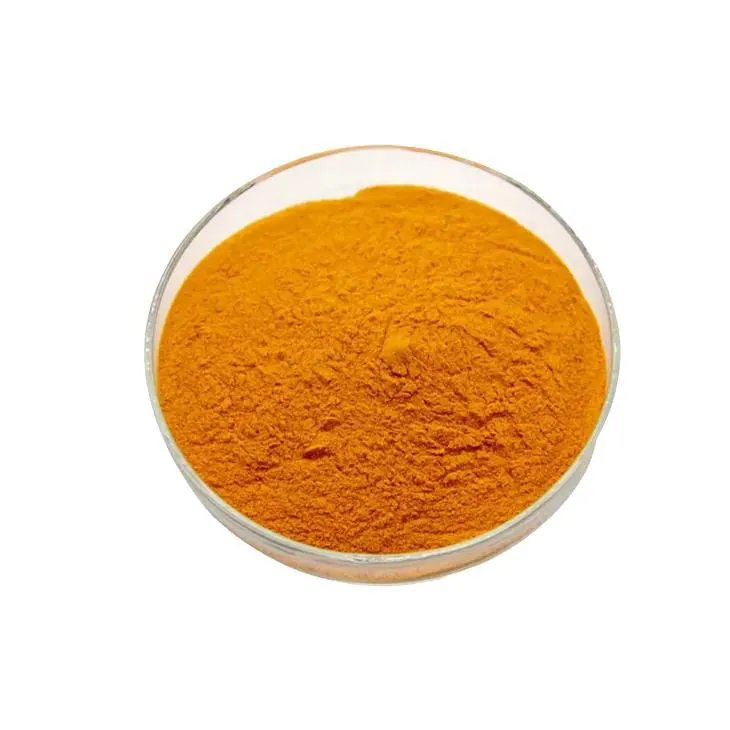- 0086-571-85302990
- sales@greenskybio.com
The best method for extracting marigold extracts.
2024-11-26

1. Introduction
Marigold (Tagetes spp.) is a widely known plant with various applications, especially due to the valuable compounds present in it. Marigold Extracts are rich in carotenoids, flavonoids, and other bioactive substances, which have applications in the food, pharmaceutical, and cosmetic industries. Therefore, finding the best method for extracting Marigold Extracts is of great significance.

2. Different extraction techniques
2.1 Solvent extraction
Solvent extraction is one of the most common methods for extracting Marigold Extracts. It involves the use of a suitable solvent to dissolve the target compounds from the marigold plant material.
- Non - polar solvents: For example, hexane can be used to extract lipophilic compounds such as carotenoids. Hexane has a low polarity, which allows it to dissolve non - polar substances effectively. However, the use of hexane also has some drawbacks. It is a volatile and flammable solvent, which requires careful handling in the extraction process.
- Polar solvents: Ethanol is a popular polar solvent for marigold extraction. Ethanol can dissolve a wide range of compounds, including some polar flavonoids. Moreover, ethanol is relatively safe and has a lower environmental impact compared to some non - polar solvents. It can also be easily removed from the extract through evaporation.
- Mixed solvents: Sometimes, a mixture of solvents can be used to achieve better extraction results. For example, a combination of hexane and ethanol may be used to extract both lipophilic and hydrophilic compounds simultaneously. The ratio of the two solvents can be adjusted according to the specific requirements of the extraction.
2.2 Supercritical fluid extraction (SFE)
Supercritical fluid extraction is a more advanced extraction technique. In this method, a supercritical fluid, usually carbon dioxide (CO₂), is used as the extraction solvent.
- Advantages: Supercritical CO₂ has properties between those of a gas and a liquid. It has a high diffusivity, which allows it to penetrate the plant material quickly and extract the target compounds efficiently. Moreover, it is non - toxic, non - flammable, and leaves no solvent residue in the extract. This is especially important for applications in the food and pharmaceutical industries where purity is crucial.
- Disadvantages: The equipment for supercritical fluid extraction is relatively expensive, which limits its widespread use. Also, the extraction conditions, such as pressure and temperature, need to be carefully controlled to achieve optimal extraction results.
2.3 Microwave - assisted extraction (MAE)
Microwave - assisted extraction utilizes microwave energy to enhance the extraction process.
- Mechanism: Microwaves can cause the polar molecules in the plant material and the solvent to vibrate rapidly, generating heat. This heat can increase the solubility of the target compounds and accelerate the mass transfer from the plant material to the solvent.
- Benefits: MAE can significantly reduce the extraction time compared to traditional solvent extraction methods. It also has the potential to improve the extraction yield and selectivity of the target compounds.
- Limitations: However, the microwave - assisted extraction process needs to be carefully optimized to avoid over - heating, which may lead to the degradation of some thermally sensitive compounds.
2.4 Ultrasonic - assisted extraction (UAE)
Ultrasonic - assisted extraction employs ultrasonic waves to disrupt the plant cell walls and enhance the extraction efficiency.
- How it works: Ultrasonic waves create cavitation bubbles in the solvent. When these bubbles collapse, they generate high - pressure and high - temperature micro - environments, which can break the cell walls of the marigold plant material and release the intracellular compounds into the solvent.
- Advantages: UAE is a relatively simple and cost - effective method. It can improve the extraction yield and reduce the extraction time. It can also be used in combination with other extraction techniques, such as solvent extraction, to further enhance the extraction efficiency.
- Disadvantages: Similar to MAE, improper ultrasonic treatment may cause the degradation of some bioactive compounds due to the generated heat and mechanical stress.

3. Optimal raw material selection
The quality of the raw material, i.e., the marigold plant, plays a crucial role in obtaining high - quality extracts.
- Species and variety: Different species and varieties of marigold may contain different levels of target compounds. For example, Tagetes erecta is known to be rich in lutein, one of the important carotenoids. Therefore, when aiming for high - lutein extracts, Tagetes erecta may be a preferred choice.
- Growth conditions: The growth conditions of marigold, such as soil type, sunlight exposure, and water availability, can affect the content and quality of the bioactive compounds in the plant. Marigolds grown in well - drained, fertile soil with sufficient sunlight are likely to have a higher content of bioactive substances.
- Harvest time: The time of harvest also has a significant impact on the quality of the extracts. Generally, marigolds should be harvested at the appropriate maturity stage. Harvesting too early may result in lower levels of target compounds, while harvesting too late may lead to the degradation of some compounds.

4. Ideal environmental factors
Environmental factors during the extraction process also need to be considered for obtaining high - quality marigold extracts.
- Temperature: For solvent extraction, the temperature can affect the solubility of the target compounds. However, high temperatures may also cause the degradation of some thermally sensitive compounds. Therefore, an appropriate temperature range needs to be determined based on the nature of the solvent and the target compounds. For example, in ethanol extraction, a temperature around 50 - 70 °C may be suitable for most marigold extracts.
- Pressure: In supercritical fluid extraction, pressure is a critical factor. Different pressures can lead to different extraction efficiencies and selectivities. Usually, a pressure range of 10 - 30 MPa is commonly used for supercritical CO₂ extraction of marigold extracts.
- Time: The extraction time should be optimized to ensure sufficient extraction of the target compounds without causing unnecessary degradation or loss. For example, in microwave - assisted extraction, the extraction time may range from a few minutes to tens of minutes, depending on the power of the microwave and the amount of raw material.

5. Comparison and selection of the best method
To determine the best method for extracting marigold extracts, a comprehensive comparison of the different extraction techniques is necessary.
- Solvent extraction: It is a relatively simple and cost - effective method. However, it may require a large amount of solvent, and the solvent removal process can be time - consuming. Also, there may be some solvent residues in the extract, which may limit its applications in some high - purity requirements industries.
- Supercritical fluid extraction: It offers high - purity extracts with no solvent residue. But the high cost of equipment and strict control requirements for extraction conditions make it less accessible for small - scale producers.
- Microwave - assisted extraction: It can significantly reduce the extraction time and has good extraction efficiency. However, the optimization of extraction conditions to avoid compound degradation is crucial.
- Ultrasonic - assisted extraction: It is simple, cost - effective, and can improve the extraction yield. But similar to microwave - assisted extraction, it needs to be carefully controlled to prevent compound degradation.
6. Conclusion
In conclusion, the best method for extracting marigold extracts depends on various factors, including the target compounds, the scale of production, cost considerations, and purity requirements. Different extraction techniques, optimal raw material selection, and ideal environmental factors all play important roles in obtaining high - quality marigold extracts. By carefully considering these factors, producers can choose the most suitable extraction method to meet their specific needs.
FAQ:
What are the common extraction techniques for marigold extracts?
Some common extraction techniques for marigold extracts include solvent extraction, supercritical fluid extraction, and microwave - assisted extraction. Solvent extraction often uses organic solvents like ethanol or hexane. Supercritical fluid extraction typically employs carbon dioxide in a supercritical state, which offers advantages such as being non - toxic and leaving no solvent residue. Microwave - assisted extraction uses microwave energy to enhance the extraction process, which can be more efficient in terms of time and yield.
How to select the optimal raw materials for marigold extraction?
When selecting raw materials for marigold extraction, several factors should be considered. Firstly, the variety of marigold matters. Some varieties may have a higher content of the desired compounds, such as lutein. Secondly, the growth conditions of the marigolds are important. Marigolds grown in a clean and suitable environment, with proper sunlight, water, and soil nutrients, are likely to produce better - quality raw materials. Also, the maturity of the marigolds at the time of harvest can affect the extraction. Generally, marigolds should be harvested at the appropriate stage of maturity to ensure a high content of the target compounds.
What are the ideal environmental factors for marigold extraction?
The ideal environmental factors for marigold extraction mainly include temperature and humidity. During the extraction process, a relatively stable temperature is required. For some extraction methods, a specific temperature range can optimize the extraction efficiency. For example, in solvent extraction, a suitable temperature can enhance the solubility of the target compounds. Humidity also plays a role. If the environment is too humid, it may cause problems such as mold growth in the raw materials, which will affect the quality of the extract. Therefore, a dry and well - ventilated environment is preferred.
How can we ensure the quality of marigold extracts during the extraction process?
To ensure the quality of marigold extracts during the extraction process, strict control of various parameters is necessary. Firstly, the purity of the solvents used in extraction should be ensured. Impure solvents may introduce impurities into the extract. Secondly, the extraction time and temperature should be carefully controlled according to the specific extraction method. Over - extraction or extraction at inappropriate temperatures can lead to the degradation of the target compounds or the extraction of unwanted substances. Additionally, proper handling and storage of the raw materials before extraction are also crucial to maintain their quality.
What are the applications of marigold extracts?
Marigold extracts have a wide range of applications. In the food industry, they can be used as a natural colorant, adding a bright yellow - orange color to products. In the cosmetic industry, marigold extracts are known for their antioxidant and anti - inflammatory properties, and are often used in skin care products such as creams and lotions. In the pharmaceutical field, certain compounds in marigold extracts may have potential health benefits, for example, lutein in marigold extracts is beneficial for eye health.
Related literature
- Extraction Techniques of Marigold Pigments: A Review"
- "Optimal Conditions for Marigold Extract Production"
- "The Role of Raw Material Quality in Marigold Extract Extraction"
- ▶ Hesperidin
- ▶ citrus bioflavonoids
- ▶ plant extract
- ▶ lycopene
- ▶ Diosmin
- ▶ Grape seed extract
- ▶ Sea buckthorn Juice Powder
- ▶ Beetroot powder
- ▶ Hops Extract
- ▶ Artichoke Extract
- ▶ Reishi mushroom extract
- ▶ Astaxanthin
- ▶ Green Tea Extract
- ▶ Curcumin Extract
- ▶ Horse Chestnut Extract
- ▶ Other Problems
- ▶ Boswellia Serrata Extract
- ▶ Resveratrol Extract
- ▶ Marigold Extract
- ▶ Grape Leaf Extract
- ▶ blog3
- ▶ blog4
- ▶ blog5
-
The best lemon juice powder in nature.
2024-11-26
-
Organic Vitamin K2 Powder Suppliers
2024-11-26
-
Bulk purchase of L - tyrosine.
2024-11-26
-
Vitamin K2 Manufacturers
2024-11-26
-
100% Pure Natural Rutin.
2024-11-26
-
Chinese Citrus Bioflavonoid Suppliers.
2024-11-26
-
Pueraria Lobata Extract
2024-11-26
-
Dandelion Root Extract
2024-11-26
-
Mulberry leaf Extract
2024-11-26
-
Propolis Extract Powder
2024-11-26
-
Buckthorn bark extract
2024-11-26
-
Maitake Mushroom Extract
2024-11-26
-
Agaricus Blazei Extract
2024-11-26
-
Red Date Extract
2024-11-26
-
Yellow Pine Extract
2024-11-26
-
Yohimbine Bark Extract
2024-11-26





















